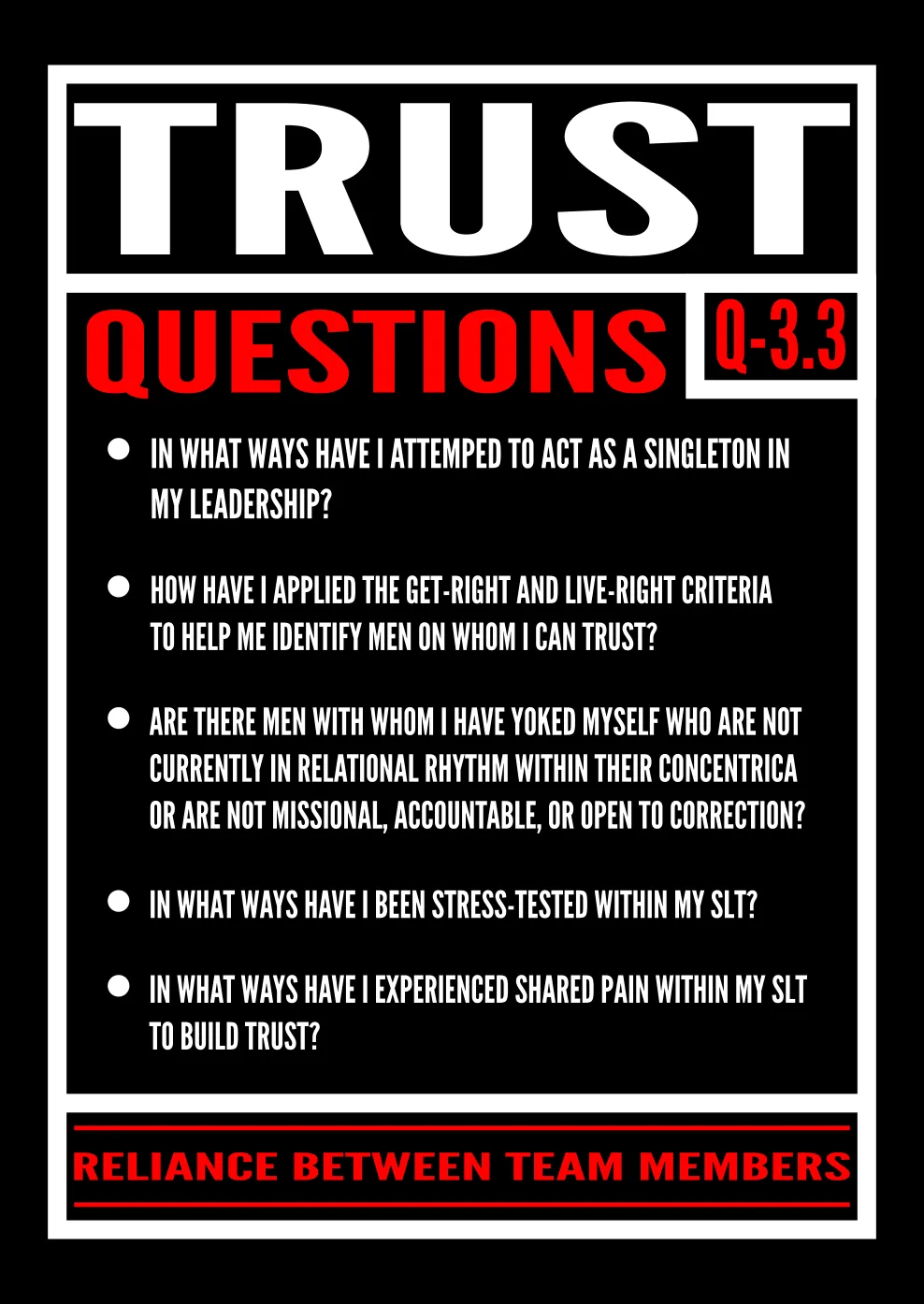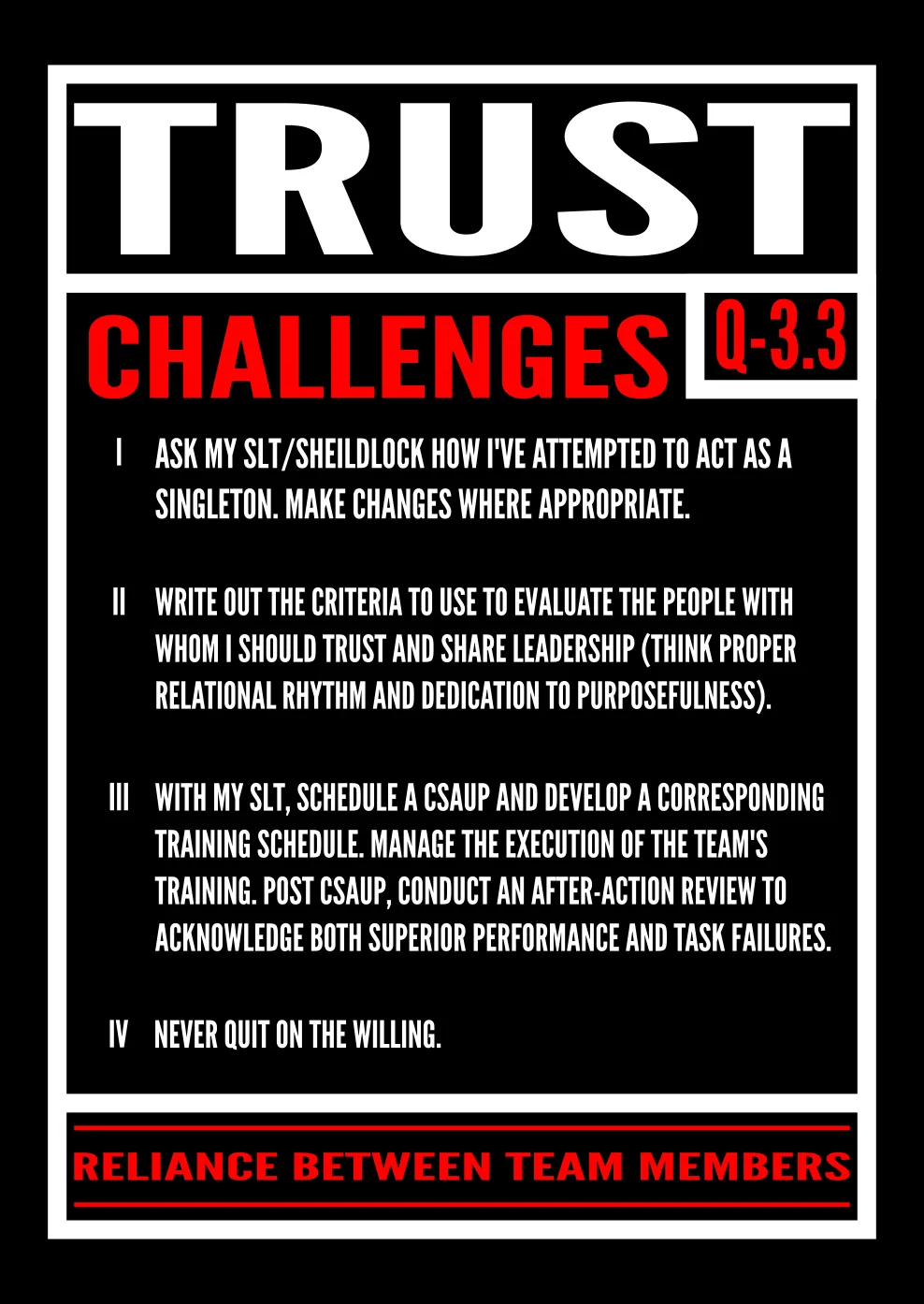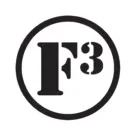TRUST (Q3.3)
Reliance Between Team Members
Trust is an essential element of Shared Leadership
The provision of Virtuous Leadership to a larger Organization or Community is a heavy responsibility. While absolutes invite criticism I will go out on that limb by saying that no Leader no matter how strong can provide Virtuous Leadership as a singleton for an indefinite period of time. Acting alone, he will succumb to his Blind Spots because there is no other man holding him Accountable. Without a Shield Lock to share the burden of walking the Twelve when he is in the Flux, he will be overcome by Inertia and cause his Group to Decelerate.
The dilemma for the Virtuous Leader is how to find men upon whom he can rely. He knows (or he will quickly learn) that going it alone is not tenable. But the risk of relying upon someone who is not Trust-worthy is high. In the military it can get men killed. In business it can lead to bankruptcy. Within a marriage it can destroy children’s lives. How does the Virtuous Leader certify another person’s Trust-worthiness before he Shares Leadership with them?
He can’t, at least not completely. But one thing a Virtuous Leader must do is apply the Get Right and Live Right as criteria. A man who is in Relational Rhythm within his Concentrica is more likely to be reliable. Conversely, if he is not, then it is very unlikely that he will be Trust-worthy. Likewise, if he is Living Right, then he is exhibiting the characteristics that will make him a Virtuous Leader in his own right. While the fact that he is Living Right in Relational Rhythm (taken alone) is not enough to assure that he will be a reliable Member of a SLT, it is a very good start. In the inverse, yoking oneself to a man who is clearly not doing so is a virtual guarantee of failure. It is very unlikely that he will be able to stand up to the stress that comes with Shared Leadership.
Stress testing builds reliance
Reliance is the heart of Trust. For a Team to be Dynamic, the Members must implicitly and fully rely upon each other to Competently perform their part of the Team’s Mission-essential Tasks. It is not enough for a man to tell his Team Members that he can do his job, or even for the Q to do so. They have to see the man in action under stress for reliance to build.
Whether it is the character of another man or a footbridge over a gorge, we only decide to step forward in reliance if we believe it is strong enough to keep us from falling. If we don’t believe a man’s character can bear the weight, we won’t rely upon him any more than we would a rickety bridge over a rushing river.
The most efficient method to gauge the strength of something is to stress test it under a controlled environment to find the point at which it breaks. We do this with a footbridge by jumping up and down on it at a point where it spans a place that won’t kill us if we break through. If a bridge can hold the jumping-me ten feet over the ground, then I assume I can rely upon it to hold the walking-me fifty feet over the gorge.
With men the stress test principle is the same, although the means and methods vary by what we need the man to do. For example, a candidate for public office is subjected to the stress of a political campaign. If he cannot withstand that without breaking down we deem him too unreliable for the pressures of the office he seeks. An attorney must shoulder the stress of the bar examination before he can be trusted to try a case. A doctor must survive the rigors of his residency before lives will be placed in his hands. Passing the stress test indicates sufficient strength to bear the weight of the real thing.
When applied to a man rather than a thing, stress testing serves a dual purpose. Like it does with the bridge, it demonstrates reliability to others. But, unlike the bridge, it also demonstrates to the man himself that the reliance of others is justified. Passing the stress test gives a man the confidence he needs to take on the responsibility of what comes afterwards. “If I got through that,” he tells himself, “then I have what it takes to get through this”. You can trust me because I am reliable–I trust myself.
Shared pain builds Trust
About my third week of Ranger School the instructors marched us to a pond in the outback of Fort Benning. There in the water was a narrow ladder that ascended forty feet to a 4 X 4 plank that spanned forty feet above and across the pond, with a rope at the other end that stretched horizontally forty feet above the pond. The idea was to climb the ladder, walk the plank and drop from the rope into the water, which was nasty and cold. There was no safety line–if you fell, you fell. It was dirty and dangerous. And, although it would have been an easy thing to do were it only five feet off the ground, walking that forty feet of plank forty feet above the water was one of the most difficult things I had ever done at that point in my life. It only took about two minutes to walk that plank, but it felt like two hours.
In truth, I didn’t want to do it. I’m certain that very few of my fellow Ranger School students wanted to do it either. And some men, maybe 5%, didn’t do it. They wanted to graduate from Ranger School just as much as the rest of us, but something within them just would not let them climb that ladder, walk that plank and drop into that water. The stress was too much.
But the others, the ones who were able to overcome the dirt, danger and difficulty, we learned something about ourselves and each other that dramatically strengthened the Trust between us. It only took two minutes, but such is the power of dirty, dangerous and difficult things to bond men together. Shared pain builds Trust.
F3 has an acronym for the dirty, dangerous and difficult things we do to build Trust. We call them CSAUPs, which stands for Completely Stupid And Utterly Pointless. This is satirical on our part because a CSAUP is neither stupid nor pointless, it is a very efficient way to share pain. A CSAUP can be an obstacle race or a GORUCK challenge or anything else that provides the opportunity for dirt, danger and difficulty. Completing it together tells the participants something about themselves and each other–that they are men upon whom others may safely rely.
The nature of the event is not important. What matters is that the Q uses the CSAUP to apply stress to his Team to build the Trust-relationship between its Members.

Additional Study Materials
Socratic
Is the reward of Shared Leadership worth the risk?
Can a man’s resolve be determined before he is called upon to put it in action?
What is the purpose of a CSAUP?
Spur
Trust is an Essential element of Shared Leadership
Stress testing builds reliance
Shared pain builds Trust
Additional Resources




Facebook
Instagram
X
LinkedIn